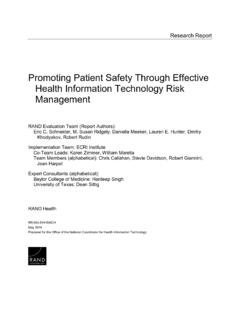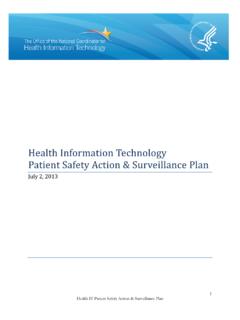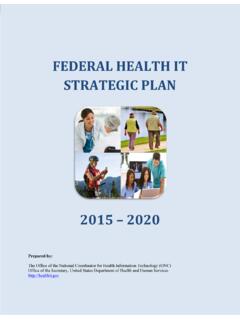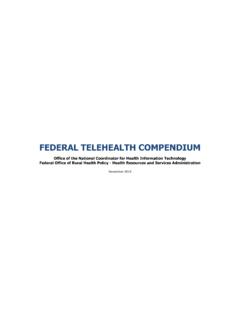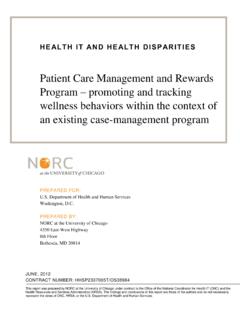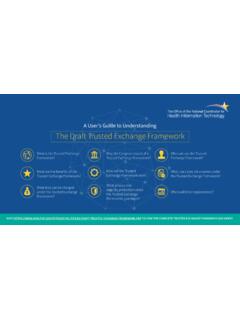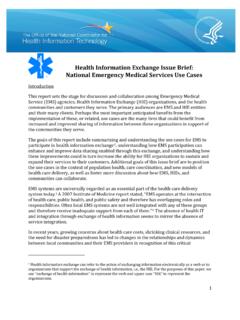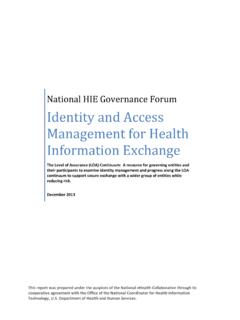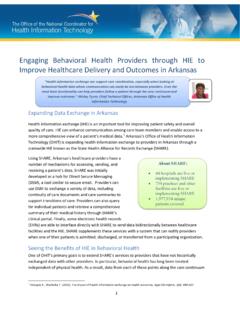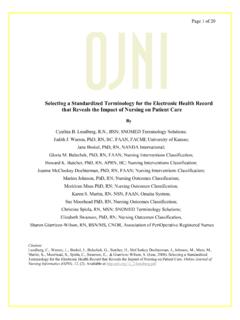Transcription of Standard Nursing Terminologies: A Landscape Analysis
1 Standard Nursing terminologies : A Landscape Analysis MBL Technologies, Clinovations, Contract # GS35F0475X Task Order # HHSP2332015004726 May 15, 2017 Identifying Challenges and Opportunities within Standard Nursing terminologies 2 Table of Contents I. Introduction .. 4 .. Analysis Approach .. of Background Data .. 7V. 8 A. Reference terminologies ..8 1. SNOMED CT .. 82. Logical Observation Identifiers Names and Codes (LOINC) .. 10B. Interface terminologies .. 11 1. Clinical Care classification (CCC) System .. 112. International classification for Nursing Practice (ICNP).
2 123. NANDA International (NANDA-I) .. Omaha System .. 166. Perioperative Nursing Data Set (PNDS) .. 187. Alternative Billing Concepts (ABC) Codes .. 19C. Minimum Data Sets .. 20 1. Nursing Minimum Data Set (NMDS) .. 202. Nursing Management Minimum Data Set (NMMDS) .. IT Developers - Perspective .. Issues in Using SNTs .. 241. Lack of Alignment on Terminology standards for Nursing Content Definition .. 242. Customized Development and Implementation of EHR Systems .. 243. Resource-Intensive Mapping Requirements, Curation and Maintenance.
3 244. Licensing Fees, Copyrights and Associated Pricing Challenges .. 255. Incomplete Electronic Documentation of Nursing Care .. 254. Nursing interventions classification System (NIC) and Nursing Outcomes classification (NOC) .. 15 Identifying Challenges and Opportunities within Standard Nursing terminologies 3 VIII. Conclusion .. 26 Appendix A: Expanded Nursing terminologies Timeline .. 27 Appendix B: Pre-Determined Landscape Assessment Questionnaire .. 34 Appendix C: EHR Developer Assessment Questionnaire .. 35 Appendix D: List of Abbreviations.
4 36 References .. 38 Identifying Challenges and Opportunities within Standard Nursing terminologies 4 I. Introduction With the rapid adoption of health IT and the promotion of interoperability to improve health, consistent standards and common data elements are the foundation for the advancement of care models. This advancement is based on objectives such as capturing sharable patient and care information across disciplines and care settings, enabling more accurate and less burdensome measurement of the quality of care delivered, and supporting ongoing research and Analysis .
5 Within this context, the Nursing profession can contribute an enormous amount of valuable data related to the care of the patient and the Nursing process. However, if Nursing data are not stored in a standardized electronic format, or easily translated to a vocabulary used by interdisciplinary care team members, the value and contributions of Nursing to patient outcomes may not be measurable or retrievable (Welton & Harper, Measuring Nursing Care Value, 2016). With more than million members, nurses constitute the largest workforce in health care, and hospital-based nurses spend as much as 50 percent of their time in direct patient care (Hurst) ( Nursing Fact Sheet, 2011) (McMenamin, 2016).
6 As we move forward with innovative strategies to optimize the health of patients and communities, the omission of Nursing data due to a lack of agreement on a standardization strategy would be unfortunate. To this end, the Office of the National Coordinator for Health IT (ONC) is working with MBL Technologies and Clinovations Government + Health, Inc. (Clinovations GovHealth) (hereafter the project team) to conduct a Landscape assessment to better understand the current state and challenges associated with using terminologies and classifications to support Nursing practice within health information technology (health IT) solutions.
7 Through a literature review and interviews with terminology owners, this assessment examines the current state of development and usage within the 12 Standard Nursing terminologies (SNT) recognized by the American Nurses Association (ANA). This report: Defines a brief history of the development of Standard Nursing terminologies and efforts to gainconsensus on a strategy for their use; Includes the level of advancement and interoperability of individual terminologies withelectronic health records (EHRs); and Identifies themes in the form of challenges and terminologies and vocabulary structures first developed in 1973, and many have changed significantly since their inceptions.
8 Realizing that the standardization of Nursing care documentation was a critical component to support interoperable health information, the ANA in 1989 created a process to recognize languages, vocabularies and terminologies that support the Nursing practice (ANA, 2015). Current action plans and guidelines, descending from the work of individuals such as James J. Cimino and organizations such as the National Committee on Vital and Health Statistics (NCVHS) and the ANA, continue to be refined (Cimino J. , 1998) (Cimino, Hripcsak, Johnson, & Clayton, 1989) (Sujansky, 2002).
9 However, the inability to ensure the availability of sharable and comparable Nursing data remains an issue. Increased focus on longitudinal and interdisciplinary documentation, care quality and value Identifying Challenges and Opportunities within Standard Nursing terminologies 5 precipitates a need to accurately quantify the contribution of each care team member for optimization of care workflows across settings. Further, high-quality Nursing data can assist in the optimal integration of registered nurses into high-value, lower-cost approaches to longitudinal care (Welton & Harper, Measuring Nursing Care Value, 2016).
10 Figure 1 below provides a high-level timeline of significant events that have occurred in the evolution and development of SNTs. A detailed and expanded events timeline is in Appendix A. Figure 1. Consolidated SNT timeline Currently, the ANA recognizes two minimum data sets, two reference terminologies and eight interface terminologies for facilitating documentation of Nursing care and interoperability of Nursing data between multiple concepts and nomenclatures within IT systems (ANA, ANA Recognized terminologies that Support Nursing Practice, 2012).
